
Eastern Panama : Cerro Azul - Bayano - Nusagandi - Darien
Birding Cerro Azul
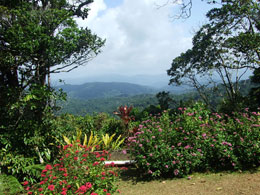 On the east side of the Panama Canal are The Cerro Azul foothills, contiguous to the Chagres National Park. This is one of the areas most visited by twitchers or birders looking to add new species on their life list. The place is located only one hour from Panama City, and the area that is most visited is the Altos de Cerro Azul Community. This is a private Mountain Community that has the advantage to be contiguous with the Chagres National Park; from here several trails make an easy and secure access to the park. The access to this area is restricted to residents; this means that you must know someone living there to get access. Birders View, Bajo Mono Trail, Maipo and the Cerro Jefe are the most visited areas.
On the east side of the Panama Canal are The Cerro Azul foothills, contiguous to the Chagres National Park. This is one of the areas most visited by twitchers or birders looking to add new species on their life list. The place is located only one hour from Panama City, and the area that is most visited is the Altos de Cerro Azul Community. This is a private Mountain Community that has the advantage to be contiguous with the Chagres National Park; from here several trails make an easy and secure access to the park. The access to this area is restricted to residents; this means that you must know someone living there to get access. Birders View, Bajo Mono Trail, Maipo and the Cerro Jefe are the most visited areas.
These foothills are very good to find species not found in the Canal Corridor; at least 49 species are known for the upper Chagres and Campana Foothills that are not present in the Canal Corridor (Engleman et al. 1995). These foothills are very good to find colorful tanagers, such as Speckled, Emerald, Bay-headed, Rufous-wing, Hepatic, and Black-and-yellow Tanager.
A variety of hummingbirds are present too; easy to find at Birders View are Violet-headed Hummingbird, Violet-capped Hummingbird , Purple-crowned Fairy, Violet-crowned Woodnymph, Bronze-tailed Plumeleteer and several Hermits such as White-tipped Sicklebill and Green Hermit. Some other birds that you must add to the Cerro Azul bird list are Yellow-eared Toucanet, the endemic Striped-cheeked Woodpecker, Black-striped Woodcreeper, White-ruffed Manakin, Scaly-crested Pygmy-Tyrant, Olive-striped Flycatcher, Blue-fronted Parrolet, Scaled Pigeon, Spot-crowned Barbet and Slate-colored Grosbeak. Some other possibilities are Black-and-White Hawk-Eagle, Speckled Antshrike and Purplish-back Quail-Dove.
Birding Bayano Lowlands
The Bayano lowland forests are located in the eastern part of the Panama Province; it is located two hours drive from Panama City. These are the western most limits for several Darien Endemics and specialties such as Barred Puffbird, Black Antshrike, Orange Crowned Oriole, White-eared Conebill and Green-and-Rufous Kingfisher; the edge of the Bayano Lake is good to look for Pied Water-Tyrant, Cocoi Heron and Pied-water Tyrant.
Bayano Previous Trip list, 2009
Birding Nusagandi - The San Blas (Kuna Yala Foothills)
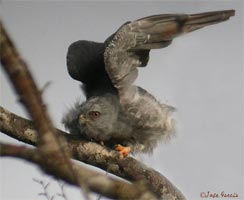 This is a wild preserve managed by the Guna Indians in their vast forested mainland territory. The site is two-hour driving from Panama City, and it is located in the lower foothills of Kuna Yala.
This is a wild preserve managed by the Guna Indians in their vast forested mainland territory. The site is two-hour driving from Panama City, and it is located in the lower foothills of Kuna Yala.
The lower position of the Continental Divide and the local weather conditions make it possible to watch several foothills species found at higher elevations in other places of Panama, such as White-ruffed Manakin, Tawny-capped Euphonia, Bay-headed Tanager, Black-and-yellow Tanager and Rufous-wing Tanager.
Several species at Nusagandi have been rarely recorded in Central Panama, some Panama Rare Birds such as: Russet-crowned Quail-Dove, Violet-capped Hummingbird, Speckled Antshrike (Xenornis) and Green Manakin, known primarily from Darien Province.
There are several trails on the sides of the road near the Divide; species found around here are the Sapayoa, Striped-throated Wrens, Thicket Antpitta and the Black-headed Antthrush. Some tanagers are the Sulphur-rumped Tanager, Olive Tanager and Dusky-faced Tanager. Nusagandi is one of the last strongholds in Panama for the Red-throated Caracara. There is a lookout point at the top of the Divide with breathtaking views of the San Blas Islands, where it is common to see King Vultures and Blue-fronted Parrolets. Birding Nusagandi offers you the chance of adding precious birds not found in the rest of Mesoamerica. It is essential to bring the bird calls of the Nusagandi birds and have a qualified guide who knows all the trails.
Nusagandi Reserve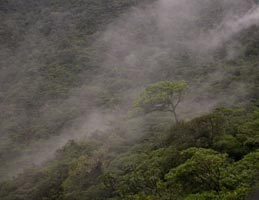 This wild preserve is managed by the Guna Indians in their vast forested mainland territory. The Kunas established 60,000 ha of mainly primary tropical rainforest to protect the high diversity of this region. The altitudes range from sea level on the Caribbean side to 850 m on the higher peaks. The Kunas run a basic-refuge at the headquarters of the preserve; it is usually empty. This area is located 2-hour driving from Panama City. A gravel road (LLano-Carti) bisects the region and it is surprisingly isolated to the sides. The gravel road was made to provide a mainland access for the Kunas living on the San Blas Islands.
This wild preserve is managed by the Guna Indians in their vast forested mainland territory. The Kunas established 60,000 ha of mainly primary tropical rainforest to protect the high diversity of this region. The altitudes range from sea level on the Caribbean side to 850 m on the higher peaks. The Kunas run a basic-refuge at the headquarters of the preserve; it is usually empty. This area is located 2-hour driving from Panama City. A gravel road (LLano-Carti) bisects the region and it is surprisingly isolated to the sides. The gravel road was made to provide a mainland access for the Kunas living on the San Blas Islands.
This area has a great potential for ecotourism, some of the things to do here are hiking to enjoy amazing waterfalls, and going to the lookout point at the Continental Divide that offers great views of the San Blas Islands.
Birding Darien
This is the most remote and wild area in Central America and it offers phenomenal birdwatching. Birding in Darien is at the top level, being home of majestic birds, such as the Harpy Eagle, Golden-headed Quetzal and Four species of Macaws. This is the only place in the Americas where the Pan-American Highway stops and does not continue to Colombia. The main means of transportation in Darien are the rivers and horses. Traveling to major points like La Palma, El Real and Cana is necessary to get closer to the National Park, and it is better done by air.
Cana Valley
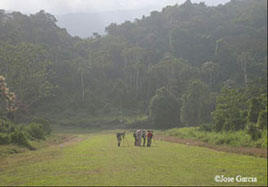 The Cana Old mine area is the birdiest site in Central America and it is regarded as one of the best places on the planet to watch birds. The site is located in the heart of the Darien National Park. The Cana field station (Currently Closed). The surroundings of the station are full of blooming trees that congregate great number of species who gather to feast on the nectar. It's hard to have a minute of rest in Cana; the amount of birds is just overwhelming. Diversity is explosive, four species of macaws fly back and forth; Chestnut-fronted Macaw, Blue-and-yellow Macaw, Great Green Macaw and Red-and-Green Macaw. Black-billed Cotinga, Dusky-backed Jacamar, Cinereous Becard, Yellow-backed Tanager, Swallow Tanager, Pacific Antwren, Sirystes, Sapayoa, Red-throated Caracara, Thicket Antpitta, Slate-throated Gnatcatcher, Rufous-winged Antwren, Crimson-bellied Woodpecker are just some of the species around the Station. Some of the birds on the higher slopes of Cerro Pirre are: Tooth-billed Hummingbird, Sharpbill, Pirre Warbler, Purple Honeycreeper, Lemon-spectacled Tanager, Ochre-breasted Antpitta, Yellow-Green Grosbeak, Choco Tapaculo, Rufous-cheeked Hummingbird, Greenish Puffleg, Varied Solitaire, Golden-headed Quetzal, Gray-and-gold Tanager, Pirre Bush-Tanager, Beautiful Treerunner, Green-naped Tanager, Yellow-browed Shrike-Vireo, Yellow-collared Chlorophonia, and Violet-throated Toucanet.
The Cana Old mine area is the birdiest site in Central America and it is regarded as one of the best places on the planet to watch birds. The site is located in the heart of the Darien National Park. The Cana field station (Currently Closed). The surroundings of the station are full of blooming trees that congregate great number of species who gather to feast on the nectar. It's hard to have a minute of rest in Cana; the amount of birds is just overwhelming. Diversity is explosive, four species of macaws fly back and forth; Chestnut-fronted Macaw, Blue-and-yellow Macaw, Great Green Macaw and Red-and-Green Macaw. Black-billed Cotinga, Dusky-backed Jacamar, Cinereous Becard, Yellow-backed Tanager, Swallow Tanager, Pacific Antwren, Sirystes, Sapayoa, Red-throated Caracara, Thicket Antpitta, Slate-throated Gnatcatcher, Rufous-winged Antwren, Crimson-bellied Woodpecker are just some of the species around the Station. Some of the birds on the higher slopes of Cerro Pirre are: Tooth-billed Hummingbird, Sharpbill, Pirre Warbler, Purple Honeycreeper, Lemon-spectacled Tanager, Ochre-breasted Antpitta, Yellow-Green Grosbeak, Choco Tapaculo, Rufous-cheeked Hummingbird, Greenish Puffleg, Varied Solitaire, Golden-headed Quetzal, Gray-and-gold Tanager, Pirre Bush-Tanager, Beautiful Treerunner, Green-naped Tanager, Yellow-browed Shrike-Vireo, Yellow-collared Chlorophonia, and Violet-throated Toucanet.
Rancho Frio Station
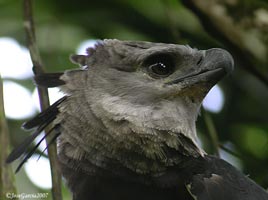 This place is a beauty; this is going to be a future ecotourism destination. It can be reached from the town of El Real; walking is only advised in the dry season, and it takes about 5 hours from El Real town to Rancho Frio. (Guides or horses should be rented at El Real). In the rainy season the station is reachable by boat, from el Real to the Piji Baisal Embera Community, and then one hour walking to the Rancho Frio Station. At the site, you find a wooden house where the park ranger lives. The house has a couple of rooms and some bunker beds for rent. There is no electricity at the place. This trip to Rancho Frio is only advisable for adventure-ecotravelers or hardcore birders. There are several trails around the house; one of them takes you in 30 minutes to a beautiful swimming waterfall.
This place is a beauty; this is going to be a future ecotourism destination. It can be reached from the town of El Real; walking is only advised in the dry season, and it takes about 5 hours from El Real town to Rancho Frio. (Guides or horses should be rented at El Real). In the rainy season the station is reachable by boat, from el Real to the Piji Baisal Embera Community, and then one hour walking to the Rancho Frio Station. At the site, you find a wooden house where the park ranger lives. The house has a couple of rooms and some bunker beds for rent. There is no electricity at the place. This trip to Rancho Frio is only advisable for adventure-ecotravelers or hardcore birders. There are several trails around the house; one of them takes you in 30 minutes to a beautiful swimming waterfall.
Some of the birds seen from el Real to Rancho Frio Station are: Black Oropendola, Agami Heron, Rufous-tailed Jacamar, Red-rumped Woodpecker, Laughing Falcon, Black Antshrike, Capped Heron, Gray-capped Flycatcher, Golden-headed Manakin and Spectacle Parrolet. At the station there are several trails good to find Crested Guan, Great Curassow, Royal Flycatcher, Golden-crowned Spadebill, Crimson-bellied Woodpecker, Red-throated Caracara, and Crested Eagle among others.
Cerro Pirre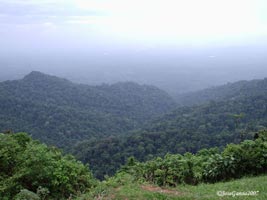 There are two main trails that can take you to the Pirre Mountain ridge from the Rancho Frio Station. One goes to a police station at the top of Cerro Pirre, at about 1200 m (10 hours), and the other takes you to Rancho Plastico (10 hours), a camping site at the south side of the ridge. These two trails should be attempted only with the local guides of the station or the ones that ANAM provides you at El Real, usually Embera People. Some of the birds seen are Black-crowned Antpitta, Ocellated Antbird, Rufous-vented Ground-Cuckoo, Stripe-checked Woodpecker, White-fronted Nunbird, Tooth-billed Hummingbird, White Hawk, Great Green Macaw, Crested Eagle, Black-and-White Hawk-Eagle, Violet- throated Toucanet, Lemon-spectacled Tanager, Scarlet-browed Tanager, Ochre-breasted Antpitta, Striped-throated Wren and Blue-and-gold Macaw.
There are two main trails that can take you to the Pirre Mountain ridge from the Rancho Frio Station. One goes to a police station at the top of Cerro Pirre, at about 1200 m (10 hours), and the other takes you to Rancho Plastico (10 hours), a camping site at the south side of the ridge. These two trails should be attempted only with the local guides of the station or the ones that ANAM provides you at El Real, usually Embera People. Some of the birds seen are Black-crowned Antpitta, Ocellated Antbird, Rufous-vented Ground-Cuckoo, Stripe-checked Woodpecker, White-fronted Nunbird, Tooth-billed Hummingbird, White Hawk, Great Green Macaw, Crested Eagle, Black-and-White Hawk-Eagle, Violet- throated Toucanet, Lemon-spectacled Tanager, Scarlet-browed Tanager, Ochre-breasted Antpitta, Striped-throated Wren and Blue-and-gold Macaw.
I would describe Birding Darien as a fascinating wild experience, the sense of remoteness, the birds and the native tribes make this an outstanding trip. There is always the possibility to find a new species for Panama. In the year 2007, two new species were added for Panama, by George Angehr (director of Science for the Panama Audubon Society). The species were the Large-billed Seed-Finch and the Yellow-hooded Blackbird.